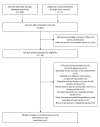Feasibility and Effectiveness of Using Wearable Activity Trackers in Youth: A Systematic Review
- PMID: 27881359
- PMCID: PMC5143467
- DOI: 10.2196/mhealth.6540
Feasibility and Effectiveness of Using Wearable Activity Trackers in Youth: A Systematic Review
Abstract
Background: The proliferation and popularity of wearable activity trackers (eg, Fitbit, Jawbone, Misfit) may present an opportunity to integrate such technology into physical activity interventions. While several systematic reviews have reported intervention effects of using wearable activity trackers on adults' physical activity levels, none to date have focused specifically on children and adolescents.
Objective: The aim of this review was to examine the effectiveness of wearable activity trackers as a tool for increasing children's and adolescents' physical activity levels. We also examined the feasibility of using such technology in younger populations (age range 5-19 years).
Methods: We conducted a systematic search of 5 electronic databases, reference lists, and personal archives to identify articles published up until August 2016 that met the inclusion criteria. Articles were included if they (1) specifically examined the use of a wearable device within an intervention or a feasibility study; (2) included participants aged 5-19 years old; (3) had a measure of physical activity as an outcome variable for intervention studies; (4) reported process data concerning the feasibility of the device in feasibility studies; and (5) were published in English. Data were analyzed in August 2016.
Results: In total, we identified and analyzed 5 studies (3 intervention, 2 feasibility). Intervention delivery ranged from 19 days to 3 months, with only 1 study using a randomized controlled trial design. Wearable activity trackers were typically combined with other intervention approaches such as goal setting and researcher feedback. While intervention effects were generally positive, the reported differences were largely nonsignificant. The feasibility studies indicated that monitor comfort and design and feedback features were important factors to children and adolescents.
Conclusions: There is a paucity of research concerning the effectiveness and feasibility of wearable activity trackers as a tool for increasing children's and adolescents' physical activity levels. While there are some preliminary data to suggest these devices may have the potential to increase activity levels through self-monitoring and goal setting in the short term, more research is needed to establish longer-term effects on behavior.
Keywords: behaviour change; electronic activity monitor; mHealth; physical activity.
©Nicola D Ridgers, Melitta A McNarry, Kelly A Mackintosh. Originally published in JMIR Mhealth and Uhealth (http://mhealth.jmir.org), 23.11.2016.
Conflict of interest statement
Conflicts of Interest: None declared.
Figures
Similar articles
-
Acceptance of Commercially Available Wearable Activity Trackers Among Adults Aged Over 50 and With Chronic Illness: A Mixed-Methods Evaluation.JMIR Mhealth Uhealth. 2016 Jan 27;4(1):e7. doi: 10.2196/mhealth.4225. JMIR Mhealth Uhealth. 2016. PMID: 26818775 Free PMC article.
-
Using the Technology Acceptance Model to Explore Adolescents' Perspectives on Combining Technologies for Physical Activity Promotion Within an Intervention: Usability Study.J Med Internet Res. 2020 Mar 6;22(3):e15552. doi: 10.2196/15552. J Med Internet Res. 2020. PMID: 32141834 Free PMC article.
-
Effects of Mobile Health Including Wearable Activity Trackers to Increase Physical Activity Outcomes Among Healthy Children and Adolescents: Systematic Review.JMIR Mhealth Uhealth. 2019 Apr 30;7(4):e8298. doi: 10.2196/mhealth.8298. JMIR Mhealth Uhealth. 2019. PMID: 31038460 Free PMC article.
-
Behavior Change Techniques Present in Wearable Activity Trackers: A Critical Analysis.JMIR Mhealth Uhealth. 2016 Apr 27;4(2):e40. doi: 10.2196/mhealth.4461. JMIR Mhealth Uhealth. 2016. PMID: 27122452 Free PMC article.
-
Effect of wearable activity trackers on physical activity in children and adolescents: a systematic review and meta-analysis.Lancet Digit Health. 2024 Sep;6(9):e625-e639. doi: 10.1016/S2589-7500(24)00139-0. Epub 2024 Aug 6. Lancet Digit Health. 2024. PMID: 39112110
Cited by
-
Agent-Oriented Goal Models in Developing Information Systems Supporting Physical Activity Among Adolescents: Literature Review and Expert Interviews.J Med Internet Res. 2021 May 19;23(5):e24810. doi: 10.2196/24810. J Med Internet Res. 2021. PMID: 34009127 Free PMC article. Review.
-
Process Evaluation of Project FFAB (Fun Fast Activity Blasts): A Multi-Activity School-Based High-Intensity Interval Training Intervention.Front Sports Act Living. 2021 Sep 20;3:737900. doi: 10.3389/fspor.2021.737900. eCollection 2021. Front Sports Act Living. 2021. PMID: 34617011 Free PMC article.
-
The utility of personal activity trackers (Fitbit Charge 2) on exercise capacity in patients post acute coronary syndrome [UP-STEP ACS Trial]: a randomised controlled trial protocol.BMC Cardiovasc Disord. 2017 Dec 29;17(1):303. doi: 10.1186/s12872-017-0726-8. BMC Cardiovasc Disord. 2017. PMID: 29284402 Free PMC article. Clinical Trial.
-
Primary School Pupils' Perceptions and Experiences of Wearable Technologies.J Sch Health. 2024 Dec;94(12):1119-1128. doi: 10.1111/josh.13509. Epub 2024 Nov 6. J Sch Health. 2024. PMID: 39502018 Free PMC article.
-
Wearable Activity Trackers in the Management of Rheumatic Diseases: Where Are We in 2020?Sensors (Basel). 2020 Aug 25;20(17):4797. doi: 10.3390/s20174797. Sensors (Basel). 2020. PMID: 32854412 Free PMC article. Review.
References
-
- Kohl HW, Craig CL, Lambert EV, Inoue S, Alkandari JR, Leetongin G, Kahlmeier S, Lancet Physical Activity Series Working Group The pandemic of physical inactivity: global action for public health. Lancet. 2012 Jul 21;380(9838):294–305. doi: 10.1016/S0140-6736(12)60898-8.S0140-6736(12)60898-8 - DOI - PubMed
-
- Andersen LB, Harro M, Sardinha LB, Froberg K, Ekelund U, Brage S, Anderssen SA. Physical activity and clustered cardiovascular risk in children: a cross-sectional study (The European Youth Heart Study) Lancet. 2006 Jul 22;368(9532):299–304. doi: 10.1016/S0140-6736(06)69075-2.S0140-6736(06)69075-2 - DOI - PubMed
-
- Janssen I, Leblanc AG. Systematic review of the health benefits of physical activity and fitness in school-aged children and youth. Int J Behav Nutr Phys Act. 2010;7:40. doi: 10.1186/1479-5868-7-40. http://ijbnpa.biomedcentral.com/articles/10.1186/1479-5868-7-40 1479-5868-7-40 - DOI - DOI - PMC - PubMed
-
- Hallal PC, Victora CG, Azevedo MR, Wells JCK. Adolescent physical activity and health: a systematic review. Sports Med. 2006;36(12):1019–30.36123 - PubMed
-
- Department of Health. [2016-11-17]. Does your child get 60 minutes of physical activity every day? Make your move - Sit less! Be active for life! Australia's Physical Activity & Sedentary Behaviour Guidelines for Children (5-12 years). 2014. http://www.health.gov.au/internet/main/publishing.nsf/content/health-pub... .
Publication types
LinkOut - more resources
Full Text Sources
Other Literature Sources
Miscellaneous



